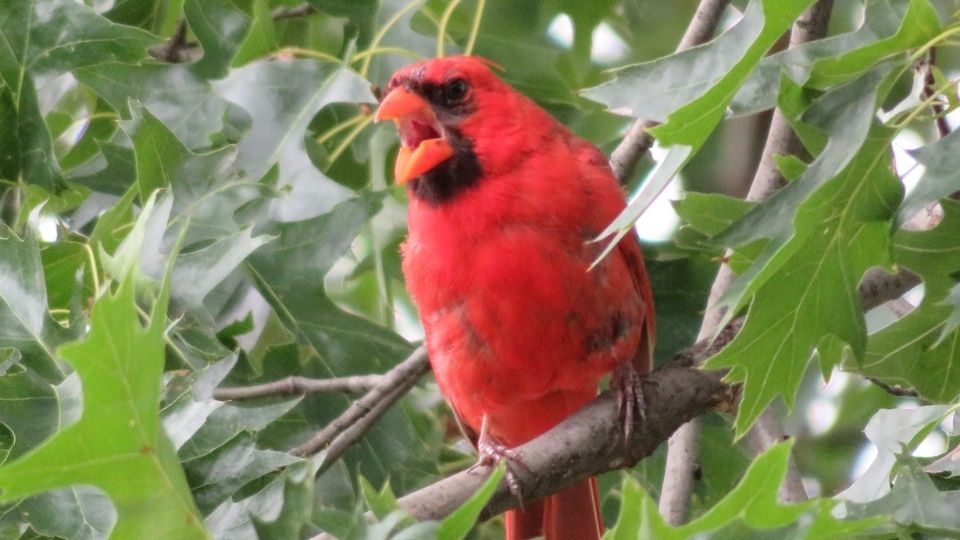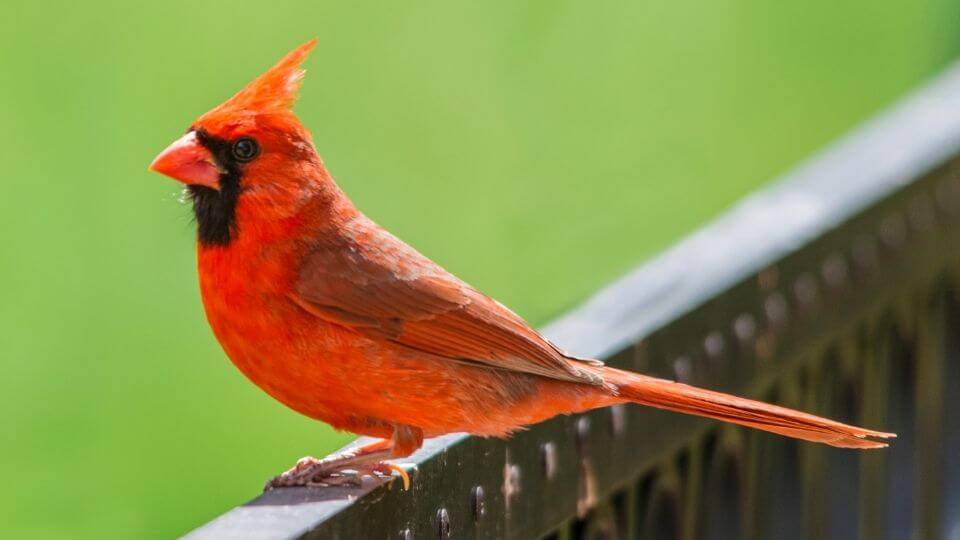Cardinal songs have a very distinct pattern, with various vocal phrases. The most common cardinal sound is a loud whistle, going higher in pitch, ending, and then being followed by a staccato trill of "pew," "pew," "pew."
There are two species of cardinals in North America with very similar songs, as well as another North American bird who enjoys mimicking the melodic cardinal song. There are many ways to tell the three bird songs apart. Knowing which wild bird is native to your area is the first step in figuring out what bird’s sound you hear.
If you’re in range for all three bird species, telling bird calls apart without a visual sighting of the bird is a little trickier. First, we’ll cover some common questions about popular backyard birds and discuss ways to identify cardinal bird sounds.
How do you identify a Northern cardinal?
The male Northern cardinal has striking red feathers, a black mask, and a red crest. Female cardinals are primarily gray with light red on their crest, wings, and tail. Both males and females have red beaks. Some female cardinals have a noticeable black mask, but others don’t.
There are two types of cardinal birds in the United States. Of the two species, the Northern Cardinal bird is typically found in North America. The Desert Cardinal (Cardinalis sinuatus) is confined to southern Arizona, New Mexico, and Texas.
They are mostly gray feathered with a red mask, red chest, and red tips on their longest feathers on the crest, wings, and tail. The female desert cardinal looks very similar to the male but with far less red feathering. Both male and female desert cardinals have a yellow beak, with the female’s beak being a lighter yellow.

What does a cardinal bird sound like?
The Northern cardinal song has a variety of sounds. The most common is a mix of two syllables, like “t-weet, tweet” followed by short, quick monosyllables that sound like “chirp, chirp, chirp.”
The Cornell Lab of Ornithology keeps sound clips of the Northern cardinal song in its Macaulay Library. There are over 15 different sounds in the northern cardinal’s vocal repertoire. Northern cardinals are one of the first wild birds to sing each year. They vocalize year-round, but male cardinals start singing to defend their territories by late January.
Cardinals are also part of the dawn chorus, a group of wild birds that starts singing before the sun comes up. But don’t assume any bird that sounds like a cardinal is this beautiful red bird. There is another North American bird that loves to mimic cardinals and many other birds.
Do other songbirds sound like cardinals?
Mockingbirds can mimic cardinals and many other birds. If you hear a cardinal but do not see a bright red bird, you might actually have a mockingbird in your backyard.
Sometimes mockingbirds will join cardinals in the dawn chorus. Listen closely, and you’ll hear the slight difference between the actual cardinal song and the mockingbird mimicry.
Another telltale sign of a mockingbird is a string of varying birdsong that alternates and never overlaps. Mockingbirds don’t sing one bird’s song at a time. They perform a cycle of wild bird songs, often in the same order each time.
If you have a prolific singer with multiple bird songs on a seemingly endless repeat, that’s typically a young male mockingbird that is not yet paired up. Once your avid singer finds a mate, his raucous singing will calm down.

Does a Northern cardinal song sound the same as a desert cardinal?
Northern and desert cardinals sound similar, but the desert cardinal song is a lower pitch. If you live in parts of Arizona, New Mexico, and Texas, where their ranges overlap, you might hear both cardinal bird species vocalizing!
When their territories overlap, Northern and Desert cardinals sometimes sing in unison. They frequently sing to establish their territory and maintain boundaries. While the two bird species have very similar vocals, the Desert cardinal–or the Pyrrhuloxia as it is sometimes called–has a more metallic quality. At the end of the song, the soft vibrating purr is a little more noticeable in the vocals of the Desert cardinal.
What does it mean when you hear a cardinal song?
Cardinals sing primarily to communicate with other cardinals and for courting purposes. Some cultures and faith traditions also believe the cardinal song is a message from lost loved ones.
Cardinals are year-round birds, and their cheerful song can be heard most of the year. What time of year it is also determined what a cardinal song means.
From late January to mid-February, male cardinals sing to attract a mate and let other males know he has chosen a territory. The mating call is similar to the cardinal’s regular song, but you may hear cardinals sing more often and aggressively while they search for a mate.
Once the breeding season begins in March, cardinals will sing to communicate with their mate. Singing and bringing the female cardinal gifts is essential to the cardinal mating behavior. When cardinals sing during courtship, you may hear a behavior called counter singing. This is when one bird sings a specific phrase, and another bird repeats the song back to them.
Many bird lovers believe there’s more to the cardinal song than a simple wild bird song. A single cardinal singing is thought to be a message of hope from the spirit realm. Because cardinals mate for life and work together to raise their nestlings, many believe hearing two cardinals singing signifies that the listener’s romantic life is about to change for the better.
Whether you’re listening to the melodic cardinal song for faith or the enjoyment of backyard birds, the sweet melody of this wild bird is a beautiful experience for all.
Watch our video and discover 10 facts about Cardinals you may not have known about!
Do female cardinals sing?
While historically, little documentation of female bird songs exists, the female cardinal is known to sing to its mate to communicate the need for food and help with feeding nestlings. During courtship and mating, the pair will sing duets together.
Northern cardinals will perform a singing behavior known as a duet, which wild birds use to communicate to their mates. While female cardinals will vocalize with other females, pair bonding through vocal duets is one of the primary reasons female cardinals sing.
When cardinals sing a duet, the female cardinal will often start the song. Even though it was once assumed only male birds sing, the singing behavior of the female cardinal has encouraged researchers to take a deeper look into the singing behavior of other bird species.
Once you know what a cardinal’s song sounds like and the different reasons why a cardinal sings, it’s relatively easy to identify a cardinal song.
Remember these tips to help you identify the wild birds with similar songs
- Know what songbirds are in your area
- If you hear a cardinal song in late winter, you’re likely listening to a male cardinal marking their territory and looking for a mate
- During the breeding season, female cardinals will use their bird call to let their mate know they’re needed at the nest
- Male and female cardinals sing duets to communicate and bond
- Desert cardinals have a lower, more metallic song than their Northern cardinal cousin
- If you can’t see the bird and it’s aggressively singing at all hours of the night, you probably hear a mockingbird
- If you hear multiple bird songs with no overlap, it’s likely a mockingbird
- Unpaired male mockingbirds are known to sing all night long, mimicking several bird songs in a continuous cycle

